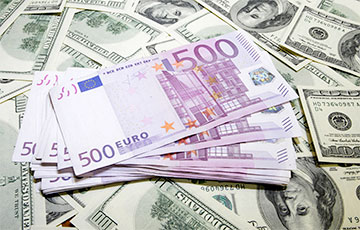Why Is Currency Market Not Stable And What Will Happen To Belarusian Ruble Exchange Rate?
9- 25.04.2022, 10:45
- 13,800

The expert forecast.
Following the February and March turmoil in the foreign exchange market, there is an opposite trend in April - the Belarusian ruble is getting stronger against the euro and the dollar. Last week the American currency rolled back to the two-month low against the ruble, and the euro - to the four-month low. The Russian ruble, on the other hand, is showing growth. What was a prerequisite for such trends and what should we expect in the future? Anastasia Luzhina, senior researcher at BEROC, shares her expert opinion with intex-press.by.
What was the prognosis for 2022 and what happened to the currency market after February 24?
When the Belarusian authorities were drawing up the state budget for 2022, the annual average dollar exchange rate was set at 2.8279 rubles. Major international organizations were not so optimistic about the Belarusian currency. For example, the international agency S & P Global Ratings reported that the dollar exchange rate in Belarus could reach Br3.04 by the end of 2022, while in 2023 - Br3.19 and in 2024 - Br3.35.
Earlier Eurasian Development Bank forecast that the average rate of the Belarusian ruble against the dollar in 2022 was expected to be Br2.67. However, the organization clarified that the uncertainty of the forecast is very high because it is difficult to assess the potential impact of sanctions by Western countries. Overall, the EDB analysts were right about the uncertainty caused by the sanctions.
After February 24, when the military conflict in Ukraine began, Western countries stepped up sanctions pressure on our country and Russia. The Belarusian currency market reacted immediately: the dollar and euro exchange rates rose markedly, while the Russian ruble fell. The situation in the foreign exchange market was like that until mid-March, then the opposite dynamics began. In the first three weeks of April, the U.S. currency and the euro fell considerably, and the Russian ruble strengthened.
As a result, since the beginning of the year the exchange rate of the Belarusian ruble against the currency basket has lowered by 4.8%. Against the Russian ruble, it has depreciated by 3.1%, against the euro - by 3.7%, against the dollar - by 8.5%.
Meanwhile, the World Bank forecasts a decline in GDP in Belarus by 6.5% this year, while the International Monetary Fund predicts a fall of 6.4%. At the same time it is not ruled out that Western countries may impose another round of sanctions, such restrictions, among other things, affect exports of our products and investment attractiveness of Belarus. All this increases the pressure on the Belarusian ruble exchange rate. This situation raises questions about what will happen in the foreign exchange market next, what the dollar and euro exchange rates will be.
How did the currency shock in Russia affect Belarus?
There is an omen at the mundane level: if you want to know what is going to happen to the Belarusian ruble tomorrow, look at what is going on with the Russian currency today.
This simple truth is based on economic and financial factors. First, our trade turnover with the Russian Federation remains high and tends to increase. Secondly, the Russian rouble accounts for 50% in the currency basket. By comparison, the US dollar accounts for 30% and the euro for 20%.
No wonder, that the February and March shocks on the foreign exchange market in Russia were immediately experienced in Belarus.
"But some peculiarities remain," says Anastasia Luzhina. "In Russia, the Russian ruble was falling more sharply against the dollar than the Belarusian ruble against the American currency. At the same time, our ruble was getting stronger against the Russian ruble".
One of the characteristic peaks happened in the first decade of March. Then the Belarusian ruble fell by 29% against the dollar, and appreciated by 20% against the Russian ruble.
For example, on March 11, the dollar exchange rate exceeded Br4.1, while that of the euro - Br4.5. On March 17, the rates of these currencies dropped markedly, after which they went up and down.
Analysts explain this specificity, in particular, by the policy of the National Bank of Belarus, which periodically acts as a buyer or seller in the foreign exchange market.
In this way it is possible to mitigate fluctuations or stretch them out in time, if they are long-lasting. This avoids one-time shocks and, as a consequence, social upheavals.
We remind that in February and March the gold and foreign currency reserves of Belarus reduced by nearly one billion dollars.
The reason of the U-turn in April
From the middle of March the trend reversed. The trend is still observed: the Belarusian ruble is getting stronger against the US dollar and the euro, but it is declining against the Russian ruble.
This may seem an unnatural situation only at first sight. Economists see this as a predictable scenario.
"Despite the imposition of sanctions, Russia has seen a reduction in imports, but key items (oil and gas) continue to be exported," comments Anastasia Luzhina. "Simply put, currency is flowing into Russia and less is being spent. Severe restrictions have also been introduced (the obligation for exporters to surrender 80% of foreign currency proceeds, a ban on purchase of currency by individuals, restrictions on provision of deposits, etc.) which allowed for administrative measures to strengthen the exchange rate".
Experts say that even before the Russian ruble had not been considered a freely convertible currency according to the international terminology. Now there are even more regulatory measures. To what extent can the exchange rate be considered market-based under the current conditions?
"If the tough measures were removed, then we would probably see a strong demand for the currency and its logical decline against the dollar," said the senior researcher at BEROC.
The economist notes that the Belarusian ruble is in a different situation and more in line with market realities, although it depends on the dynamics of the Russian ruble, not what measures have made it stable.
"In general, the Belarusian ruble rate is set on the basis of supply and demand in the domestic market," - Anastasia Luzgina's assessment is based on the analysis of the volume of trading and other parameters. "Most likely, the National Bank came out with interventions in March when there were divergent trends: appreciation against the Russian ruble and decline against the dollar. But, as before, it acted as a seller (or a buyer) only to smooth out short-term fluctuations".
What will happen to the rouble by the end of the year?
Obviously, the situation on the currency market now depends not so much on economic factors, but rather on political factors. Nevertheless, journalists asked the senior researcher of BEROC to make a forecast about the rate of the Belarusian ruble.
"For some time, a slight decline of the Russian ruble against the dollar is possible, which will inevitably have an impact on our currency market," believes Anastasiya Luzhina. "However, a lot depends on the further influence of sanctions on the Russian economy and the inflation rate. If the situation deteriorates, the corresponding trends will be observed in the RB, i.e. the Belarusian ruble will fall against the dollar and the euro".
The economist makes an important point about a number of hard-to-predict factors that could also make a significant difference.
"But the way the domestic situation inside Belarus affects the exchange rate is more predictable," she continues. "At the moment the economy is running on available reserves. But in terms of foreign trade, the situation has deteriorated. Thus, the Ukrainian market, which used to be one of the major markets for Belarus, has been lost (in particular, oil products were exported there). Also, the logistics of exports became more complicated because of the ban on traffic of Russian and Belarusian cargo carriers in the EU countries".
The service market is shrinking not only in the transportation sector, but also in the IT industry, and this is also likely to put pressure on the Belarusian ruble exchange rate. It is precisely in trade in services that there has been a surplus in recent years. Limited foreign exchange earnings will affect the exchange rate of the Belarusian rouble.
"Inflationary processes should also be taken into account," warns Anastasia Luzhgina. "Because of external shocks, costs are rising, suppliers are adding risks to the cost of production, and logistics problems are being experienced. All this is reflected in prices".
We remind that in March, the annual inflation in Belarus reached 15.9%. This is a record high in the past 10 years. At the same time, prices of goods and paid services have risen by 9.4% YTD.
According to the economist, reorientation towards other markets is hypothetically possible, but it will take time - one cannot reconstruct logistics chains within a month.
"In my opinion, if the current trends and the same exchange rate remain, we will see a gradual reduction of the Belarusian ruble against the three major currencies within a year," forecasts the senior researcher of BEROC.
She also reminds that the authorities will have to devalue the Belarusian ruble against the Russian ruble in order to remain competitive in the Russian market.










